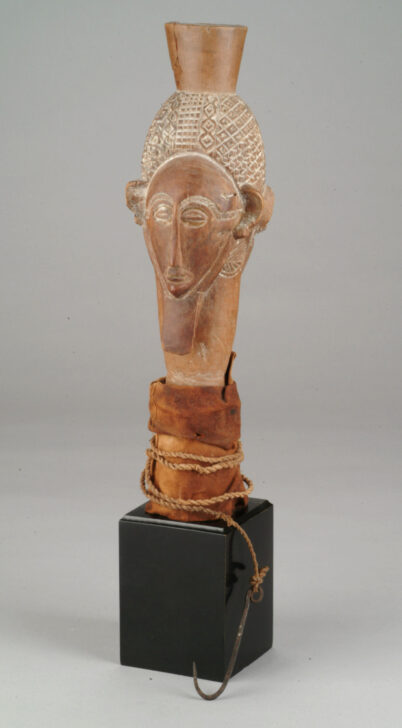Double-Faced Power Figure
Luba

Description
Subject Matter:
This object of power in the form of a carved, wooden janus, or double-faced bust, is attributed to the eastern Luba (also known as the Luba-Hemba) who resided what is today the Democratic Republic of the Congo. Similar busts depicting two or three faces known as kalunga are seen among the nearby Bembe and Buyu.
Falling under the Luba sculptural genre known as minkisi mihasi, objects such as this one are regarded as receptacles of the spirits of deceased, beloved relatives or revered ancestors. The owners of such objects would call upon these spirits in order to procure good health, fortune, and safety against any harm.
The faces on this bust likely depict a pair of Luba ancestors whose help is sought for the welfare and protection of the family lineage. As such, the bust serves as a visual and tactile reminder of the deceased spirit's assured assistance in individual and communal matters. Additionally, the bust features a cavity in the fontanelle region of the crown, the site where communication with spirits take place. Potent medicinal substances specially crafted by a Luba kilumbu, a healer and clairvoyant medium, would have been placed inside this cavity on behalf of a client seeking the spirits’ aid. Finally, the bust’s two faces symbolize dualities and oppositions: the past and the future, the visible and the invisible, life and death, and the earthly realm and the spiritual realm. However, taken as a whole, the bust possesses the quality of omniscience.
Reference:
Maurer, Evan M. and Niangi Batulukisi. Spirits Embodied: Art of the Congo, Selections from the Helmut F. Stern Collection. Minneapolis: The Minneapolis Institute of Arts, 1999.
Physical Description:
This janus, or double-faced carved wooden bust, is characteristic of the eastern Luba style, also known as the Luba-Hemba style. The elongated, ovoid-shaped faces, thin, long noses, and eyes surrounded by ocular cavities are traits typically seen in Hemba figural work. The motifs on the temples and forehead and the intricate geometric designs decorating the head depict actual Luba scarifications. Both faces closely resemble each other and feature long beards. A round cup sits atop the large, convex head; this cup conceals a cavity in the crown, allowing medicinal substances to be held inside. Wrapped around the bust’s long neck is a piece of brown cloth that has been held in place by a cord. A hook has been attached to this cord allowing the object to hang undisturbed in order to safeguard it when not in use.
Usage Rights:
If you are interested in using an image for a publication, please visit https://umma.umich.edu/request-image/ for more information and to fill out the online Image Rights and Reproductions Request Form.